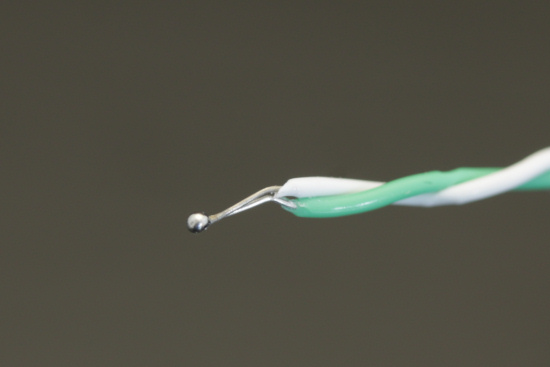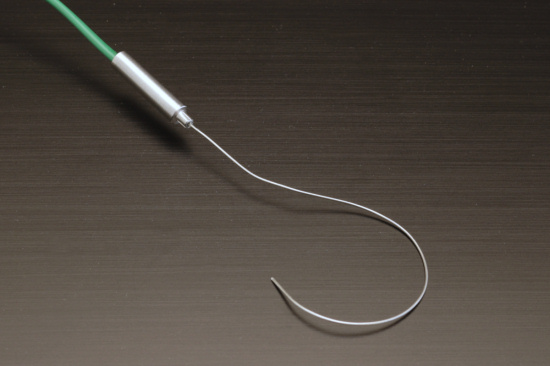![]() From time to time, a customer contacts Yoctopuce support to complain about significant instabilities on measures performed with a Yocto-Thermocouple. Each time, the conclusion is the same: the instabilities are the result of an unwanted ground loop. The Yocto-Thermocouple is not an electrically isolated module: there is no electric separation between the measuring part and the USB part. This has consequences that you must clearly understand. This is what we are going to explain this week.
From time to time, a customer contacts Yoctopuce support to complain about significant instabilities on measures performed with a Yocto-Thermocouple. Each time, the conclusion is the same: the instabilities are the result of an unwanted ground loop. The Yocto-Thermocouple is not an electrically isolated module: there is no electric separation between the measuring part and the USB part. This has consequences that you must clearly understand. This is what we are going to explain this week.
How a thermocouple works
First of all, let's make sure that you know how a thermocouple works. A thermocouple is made of two metallic wires, using specific metallic alloys. The two wires are put it contact with soldering at one end, called the measuring point. Putting these two alloys in contact creates a very low voltage at the other end of the wires. And this voltage depends on the temperature. The Yocto-Thermocouple can measure this voltage and deduce the temperature at the measuring point.

How a thermocouple works
Ground loops
Obviously, this works properly only if nothing comes to disturb the weak electric current generated by the thermocouple wire. If part of the current manages to escape through another way, or worse if a parasitic current manages to go through the wire, measures are strongly altered.

The measuring current must go through the thermocouple wire and nowhere else
The thermocouple wire sold with the Yocto-Thermocouple is a quite ordinary type K thermocouple wire: its soldered end is bare and obviously conductive.

End of an ordinary thermocouple wire: the soldering is bare
This simplicity has an important advantage: this type of wire is extremely reactive to temperature changes: little material, little thermic inertia. Disadvantage: the end is conductive and not isolated, if the current manages to reach the Yocto-Thermocouple through another way than the thermocouple wire, the measures are distorted. The classic case is the ground loop: the end of the thermocouple is in contact with a more or less conductive material which is in one way or another connected to the ground. Consequence: part of the measuring current reaches the Yocto-Thermocouple through the USB ground. The case is extremely frequent: for safety, all the machines working on the mains have their metallic parts connected to the ground. So if you try to measure the temperature of a material, even weakly conductive, which touches some metallic part of a machine, you are probably going to be in trouble.
To illustrate this phenomenon, we set up a small experiment consisting in measuring the temperature of salted water in a metallic container.

Small experiment: measuring the temperature in a container connected to the ground
As long as the container is isolated, everything goes well. However, if you are unfortunate enough to connect it to the main ground, trouble starts. The course of the experiment is summarized in the graph below. We waited 30 seconds, then we connected the container to the ground, which immediately caused large measurement disturbances.

Connecting the metallic container to the ground creates a measure instability
Obviously, all of this depends on the fact that the Yocto-Thermocouple is not an isolated module. If it were isolated, a potential parasitic current could not cross the isolation barrier between the USB part and the measuring part. However, if we had isolated the module, the Yocto-Thermocouple would have been much larger and much more expensive. When we designed the Yocto-Thermocouple, we decided not to isolate it because it is easy to work around the issue.
How to solve the issue
There are several ways to avoid this issue:
Isolating the end of the thermocouple wire
There are thermocouple wires with "mineral isolation" guaranteeing that the end of the wire is electrically isolated from the outside. Replace your ordinary thermocouple wire with isolated wire and the problem disappears.

The easy solution: use an isolated thermocouple
Get rid of the ground loop
You can also break the ground loop by making sure that the power supply of the Yocto-Thermocouple is perfectly isolated. For example, if the Yocto-Thermocouple is directly connected to a laptop working on its battery, you won't have a problem. Note that you are more likely to have a correctly isolated electric power supply with high end equipment. In our experiment, we were able to detect that the ground loop was coming from the USB hub power supply, not from that of the laptop. For desperate cases, there are isolated USB hubs with down ports electrically isolated from the up port and from the power supply, but don't be surprised if you have to break your piggy bank to get one.
Switch technology
In desperation, you can always switch technology: the Yocto-PT100, for example, is an isolated module with which you won't have this kind of trouble. But be aware that PT100 are usually not as reactive as thermocouples.
As a conclusion, here is a little video we made to show these nasty ground loop problems and how to solve them. You will also notice the inertia difference between thermocouple wires and PT100 probes.


